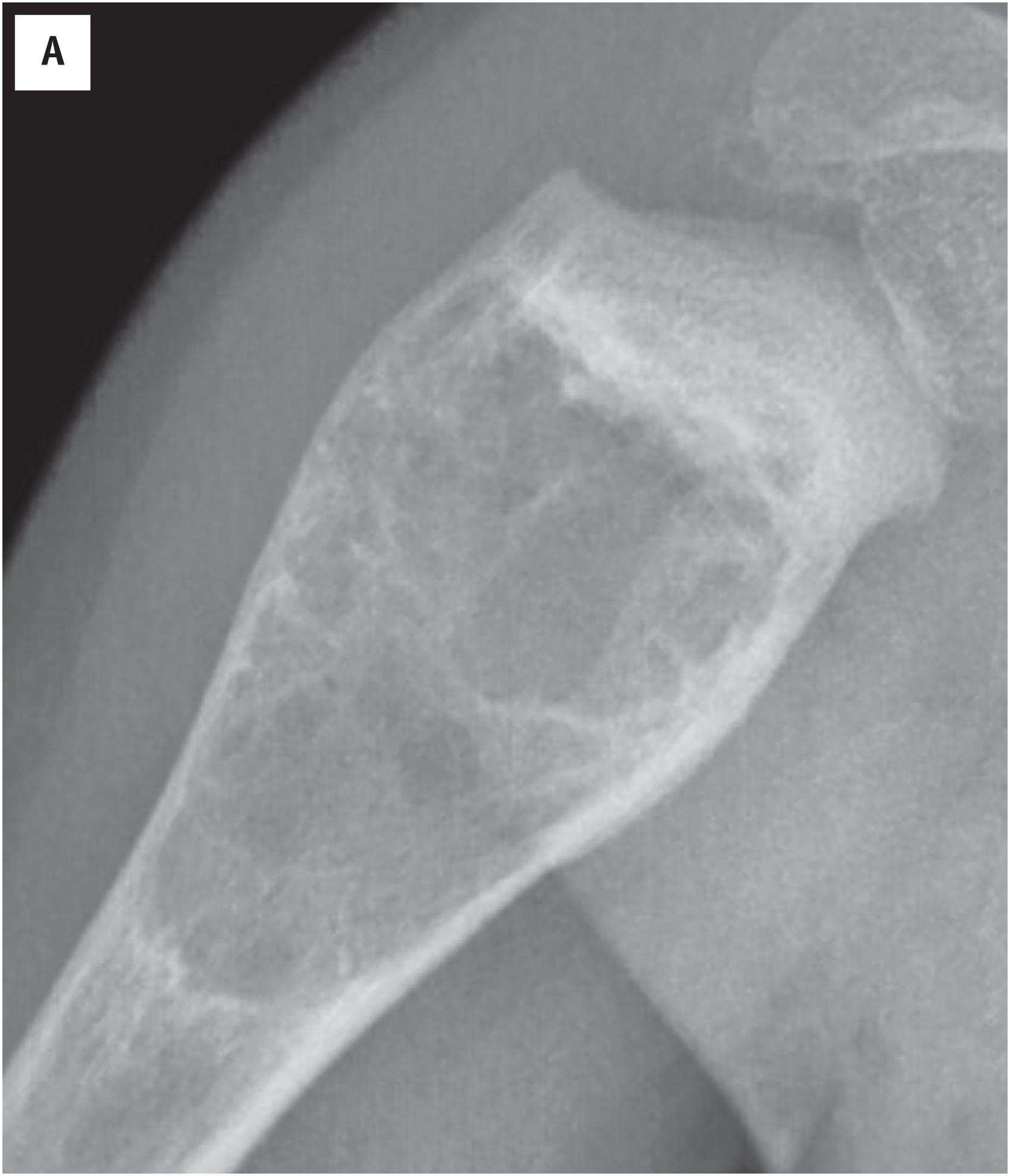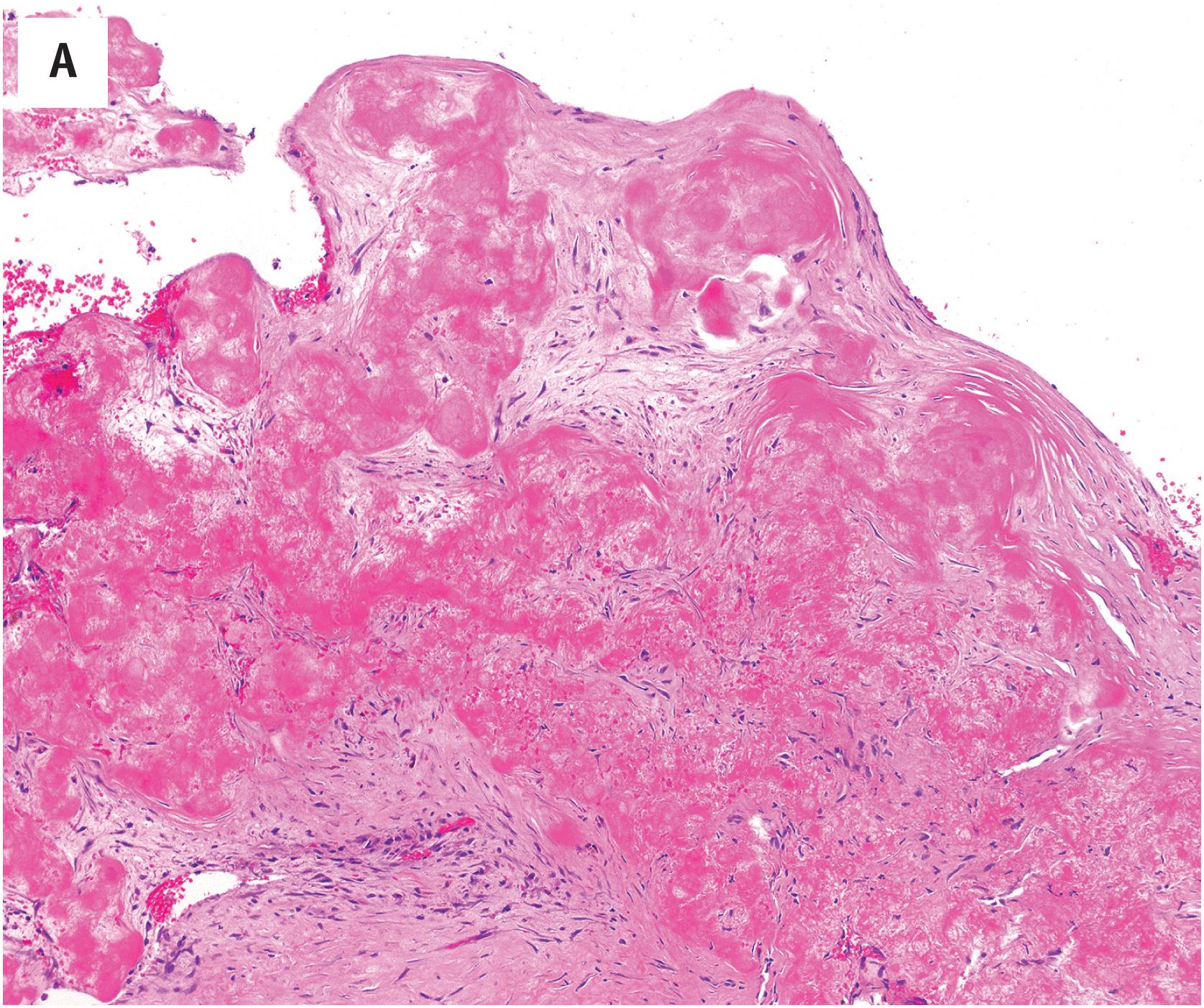Physical Address
304 North Cardinal St.
Dorchester Center, MA 02124
A variety of cystic lesions may arise within bone ( Table 23.1 ). Additionally, many neoplasms may undergo secondary cystic changes, and adequate tissue sampling is therefore essential ( Table 23.2 ). In this chapter, we will address the clinical, radiographic, and pathologic features of simple (solitary, unicameral) bone cyst, aneurysmal bone cyst, subchondral bone cyst, and ganglion cyst of bone.
| Simple (solitary/unicameral) bone cyst |
| Aneurysmal bone cyst |
| Subchondral bone cyst |
| Ganglion cyst |
| Giant cell tumor |
| Chondroblastoma |
| Fibrous dysplasia |
| Metaphyseal fibrous defect |
| Chondromyxoid fibroma |
| Telangiectatic osteosarcoma |
Simple bone cyst, also known as unicameral or solitary bone cyst, is a unilocular to multilocular, intramedullary cyst, associated with minimal to no bone expansion. Although the pathogenesis is unknown, recent studies suggest it is a neoplastic process.
Virtually any age may be affected, but most (80%) arise during the first two decades of life. There is a male predominance. Most simple bone cysts are asymptomatic and represent incidental findings. However, clinical symptoms may include localized pain, pathologic fracture, soft tissue swelling, and/or joint stiffness. More than 80% of solitary bone cysts occur in the metaphyseal regions of the proximal humerus and proximal femur ( Fig. 23.1A–C ). Simple bone cysts are rare in adults, and show somewhat different localization, more often involving the pelvic bones, especially the ilium, and the calcaneus ( Fig. 23.2 ).


Simple bone cysts form purely lytic, well-marginated, metaphyseal-centered lesions, often abutting the physis and arising within skeletally immature (open physis) patients ( Figs. 23.1A–C and 23.2A–B ). Frequently the growth plate grows at a faster pace than the cyst, resulting in the appearance that the cyst has “migrated” away from the physis toward the diaphysis ( Fig. 23.1C ). As a general rule, the affected bone appears slightly expanded but does usually exceed the width of the adjacent physis. Although the overlying cortex may be thinned, it is not penetrated. In some cases, the solitary bone cysts may become quite large but remain sharply marginated. In the setting of a pathologic fracture a portion of cortical bone often drops to the bottom of the cyst, a feature referred to as the “fallen fragment sign” ( Fig. 23.1C ). The “rising bubble sign” refers to the presence of a gas bubble in the most non-dependent portion of the cyst. MRI confirms the fluid content of the cyst ( Fig. 23.2B ).
Simple bone cyst is characteristically a unilocular, intramedullary, cavitary lesion containing clear to slightly yellow fluid. Despite the large size of some lesions, the amount of material generally obtained by curettage rarely exceeds more than a single slide. The cyst lining ranges from thin, single cell strips to broad fibrous tissue septa containing variable numbers of multinucleated osteoclast-type giant cells ( Fig. 23.3A–B ). Frequently, the cyst wall shows some myxoid change ( Fig. 23.4 ). Additionally, aggregates of eosinophilic fibrin-like debris, sometimes calcified, resembling dental cementum, are observed and are quite characteristic of a simple bone cyst ( Fig. 23.5A–B ). Even in the absence of a fracture, calcifications and reactive bone may be evident (rarely extensive) within the cyst wall. Simple bone cysts with secondary fracture may contain small areas indistinguishable from an aneurysmal bone cyst ( Fig. 23.5C–D ).



Recent studies have identified FUS-NFATC2 or EWSR1-NFATC2 fusions in simple bone cysts. USP6 rearrangements, typically present in aneurysmal bone cysts, are absent.
The differential diagnosis mainly involves an aneurysmal bone cyst (ABC). Radiographically, simple bone cysts are minimally (to non) expansile lesions, typically occur in younger children, often less than 10 years of age, and generate minimal amounts of tissue, rarely occupying more than one tissue block.
The therapy of solitary bone cyst remains controversial. Traditional treatment has included bone curettage and packing with bone chips. More recent therapy includes aspiration and removal of cyst fluid followed by steroid injections. Decompression techniques also have been utilized. The overall local recurrence rate is similar for most types of therapy, ranging from 10% to 20%. It appears that the rate of local recurrence is higher among patients younger than 10 years of age. Other factors that may increase the likelihood of local recurrence include the size of the lesion and the presence of a fracture. Spontaneous healing following pathologic fracture occurs in up to 10% of patients.
Intramedullary, generally unilocular cystic lesion lined by a thin fibrous membrane and containing serous or serosanguineous fluid
3% of all bone lesions
Metaphyseal regions of the proximal humerus, femur, and tibia
More common in males than females (M:F ratio, 2:1)
Majority of patients present in the first 2 decades of life (skeletally immature)
Mild pain to asymptomatic
Pathologic fracture
Intramedullary, circumscribed and lytic, no to minimally expansile, with peripheral ossified rim
Metaphyseal centered
Fracture fragments may produce the so-called fallen fragment sign
MRI confirms the fluid content
Local recurrence rates occur in up to 20% of patients
Factors increasing the likelihood of recurrence include older age, large cyst size, and presence of fracture
Treatments may include curettage, steroid injections, and decompression techniques
Spontaneous healing may occur in up to 10% of patients
Minimal curettage material generally limited to a single glass slide/block
Fibrous and cystic material with scant fragments of bone
Variably thickened but usually thin fibrous septa with focal myxoid changes and reactive bone
Aggregates of fibrin to cementum-like material
Aneurysmal bone cyst
Intraosseous ganglion cyst
Become a Clinical Tree membership for Full access and enjoy Unlimited articles
If you are a member. Log in here